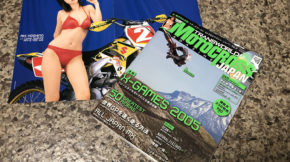Send It Or Nah | Data On Blake Baggett’s 2019 Daytona Supercross Wall Jump
Share

INSTAGRAM | @blakebaggett4
INSTAGRAM | @litpro
Blake Baggett’s ballsy move in the 450 Main Event at the 2019 Daytona Supercross to launch off a wall jump instead of just coasting over the obstacle was one of the must-see moments of the weekend. The steep single-jumps have long been used in the Daytona Supercross track designs and we’ve seen a number of riders send it off the same style jumps at the race, most famously James Stewart. Baggett’s move at this year’s race was unique, in that he was the first person of the entire day to do it and waited until he was the leader in the night’s final race to let it out; Eli Tomac soon followed suit and at one point the two flew side-by-side.
Was it really a faster way to get around the track or more of a mind game with competitors? That was the first thing that came to my mind as I stood next to the jump on Saturday night. Baggett’s jump was impressive, no doubt, because he maintained control through it all even as the WP suspension went all the way through the stroke. But the flat landing led the riders right into a long, technical rhythm lane that rewarded timing and technique more than all-out speed. I suspected that Baggett had to slow down before the section and reached out to Michael Ford of LITPro for further information.
If you’re not familiar with LITPro, here’s a quick rundown: LITPro is the small black box that you see on top of the helmet of many racers that charts a course layout via GPS and collects data like speed, jump height and distances, and g-forces. It’s become a must-use piece of equipment for race teams because of the way it clearly maps out the fastest ideal line around the track. But that’s not to say that it’s a tool only for the top riders, because we’ve ridden hundreds of laps with a LITPro and can say with certainty that it has improved our skills.
After going through the data from Baggett’s LITPro unit, Ford compared laps that Baggett jumped the wall to laps that he coasted over it, and found that it was indeed faster to jump the wall. How much faster? “For Blake, it was 0.2 to 0.3 seconds faster to launch the wall,” shared Ford. What does the break down to in other terms of measurement? “The average speed through the wall section (1.5 seconds of travel before and after the wall) when launching was 27.8 miles per hour, while the average speed for the same part of the track when not jumping was 20.5 miles per hour.” The g-force of the landing was 10.7 gs, but Ford said that this is not a mind-blowing number at the pro level and that he actually experienced 18 gs when going through the transition of a rhythm section.
Sounds like a massive gain, right? Not exactly, because Ford said the increased speed was negated almost immediately after the wall, when riders that rolled the jump got back on the throttle and increased their pace. “That seven mile per hour improvement in average speed didn’t last long because as soon as the other riders got on the throttle, the gains disappeared,” explained Ford. In addition to this, the long rhythm lane that followed the wall jump also had an impact on the gain and Baggett had to slow down to set up for the line of jumps ahead (riders that did not jump the wall had to slow down for the section as well, but not as drastically).
So, was it worth it? That’s tough to say, because data shows that the gains were considerable on their own but were offset almost immediately. However, the mental element “I jumped something no one else has yet,” could have been a big part, something that’s impossible to track. We will forever see riders attempt big moves like this and the risk-versus-reward will still come down to their own personal views.



































